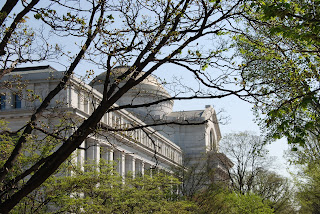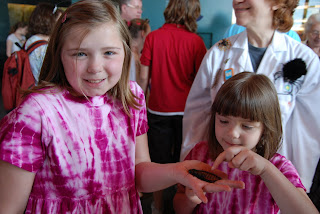Washington, D.C. - A-LOT-A History
The Smithsonian Museum of
Natural History
Our second day touring D.C., we visited The Museum of Natural History and The Museum of American History. The amazing architecture of the buildings was worth the trip in and of itself!
Our first stop at the Natural History museum was the infamous Hope Diamond. The Hope Diamond is a large, 45.52 carats deep-blue diamond. Not only is it famous for being big and beautiful, it is famous for its illustrious and sordid past. According to legends, the original form of the Hope Diamond was stolen from an eye of a sculpted statue of the goddess, Sita, the wife of Rama, the seventh avatar of Vishnu. Because it was believed to have been stolen, it was also believed to have been cursed! While this tale is believed to be the invention of the Victorian era to add mystique to the stone and increase its sales appeal, I could imagine it would make a pretty good statue eye. The stone actually glows in the dark! After exposure to short-wave ultraviolet light, the diamond produces a brilliant red phospherescence "glow in the dark" effect that persists for some time after the light source has been switched off. I think it would make a great Indiana Jones movie!
Here's the diamond's sultry history in a nutshell. The Hope Diamond is believed to have been cut from the Tavernier Blue diamond which was brought to Europe from India in the mid-1600's. In 1678, Louis XIV commission the court jeweler to recut the diamond and it was thereafter known as the Blue Diamond of the Crown. Later historians simply called it the French Blue.
In 1749, King Louis XV had the French Blue set into a more elaborate pendant. Marie Antoinette is often cited as a victim of the diamond's "curse", but she never wore the pendant, which was reserved for the use of the king. In 1792, during the reign of Louis XVI, a group of thieves broke into the Royal Storehouse and stole most of the Crown Jewels. The French Blue was among the missing. The Hope Diamond was believed to have been cut from the French Blue as means to disguise it. A similar diamond was recorded in the possession of the London diamond merchant Daniel Eliason in September 1812, the earliest point in which the history of the Hope Diamond can be definitively fixed.
At some pointe, the Hope Diamond is believed to have been possessed by King George IV of the United Kingdom. After his death in 1830, it was allegedly stolen by his mistress, Lady Conyngham, and the diamond was no longer retained by the British Royal family. Serves him right. In 1839, the Hope Diamond appeared in a published catalog of the gem collection of Henry Philip Hope, a prominent Anglo-Dutch banking family. After his death, his nephews fought over his inheritance. Ultimately, the oldest nephew, Henry Thomas Hope won the jackpot. When Henry Thomas Hope died, it went to his wife, Anne Adele. When she died, the entire estate went to her grandson who had to change his name to Lord Francis Hope. He was not allowed to sell the diamond, except by permission of the court.
Lord Francis married his mistress (I'm seeing a trend here), American actress, May Yohe. She may have been more in love with the diamond that with Lord Francis, because May ran off with Putnam Strong, son of former New York City Mayor, William L. Strong. Francis dumped her. Lord Francis finally sold the diamond. It went to a London Jewel Merchant, a U.S. diamond dealer, a Sultan from Turkey, to a Parisian jewel merchant and was finally bought, in 1920 by famed jeweler, Peirre Cartier. He reset the diamond and sold it to socialite, Evalyn McLean. When she died, the trustees used the diamond to settle her debt. (Another theme - it's owners living the high life beyond their means!) In 1949 it was sold to another famous diamond merchant, Harry Winston. Harry Winston donated it to the Smithsonian Institution in 1958 where it can still be viewed today.
As for the diamond curse? The only curse at the Smithsonian was having a man design only two teeny tiny remote bathrooms for this entire enormous museum!
Some other interesting finds included the "Jamestown Boy" which the kids remembered from our visit to Jamestown.
A gray whale skeleton,
and GIANT BUGS!
I'm sorry, but I live a little too far south to get excited about this one. I have seen a "friendly" cockroach as big as this climbing up my wall!
We found a "fish" mouth skeleton big enough to hold Jonah and his entire family
And, of course, dinosaur bones. Ella wanted to know why they were not walking around like in the movie, "Night at the Museum!'
The Smithsonian National Museum of American History
We spent most of the day at the Museum of Natural History, but I vowed I would not leave until we had gone to the Museum of American History.
The girls had to see the First Ladies' Inaugural Gowns!
At this point, my husband feigned exhaustion and he and my son took shelter in a cool movie room with benches. After the girls and I admired the gowns, we all stood in a 30 minute line to see the famous Ruby Slippers!
The Ruby Slippers were the shoes worn by Dorothy in the 1939 MGM movie, The Wizard of Oz. Because of their iconic stature, they are now considered to be among the most valuable items of film memorabilia.
Next to the Ruby Slippers I found Apollo Ohno's speedskates. (My only reason for watching the Olympics this year!)
We saw Lincoln's silk Top Hat which he wore to Ford's Theatre the night he was assassinated.
At last, in the basement of the Museum of American History, we came every Food Bloggers Mecca: Julia Child's Kitchen!
Loaded with every conceivable pot, pan and gadget, this kitchen changed America.
Au Revoir and Bon Appetit!



























Comments